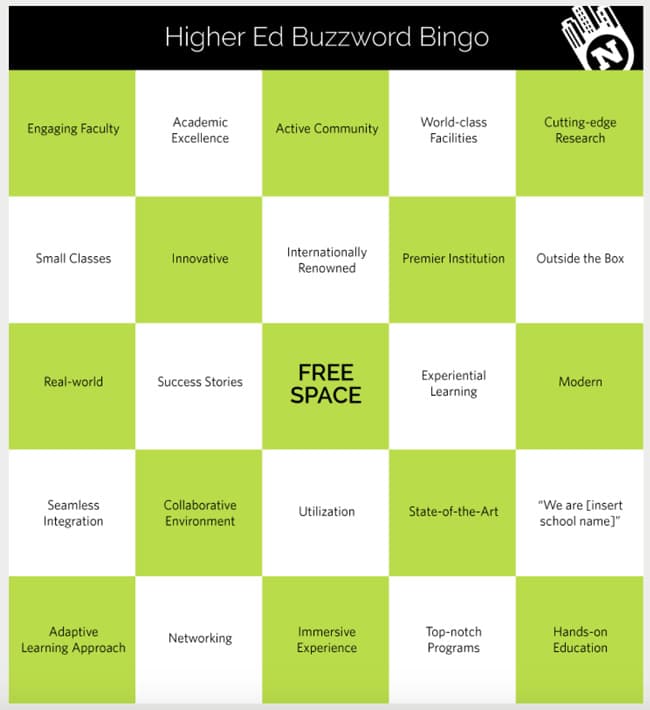Can you spot the difference? The search for a distinct education brand
Many institutions are giving greater attention – and budget – to branding these days. Consultants are brought in, new logos and taglines are fashioned, and then a whole suite of brochures, videos, and websites is produced. But, ironically, the strategies that many universities and schools hope will differentiate themselves in the marketplace often end up making them look like everyone else. Branding experts are noticing a distinct "sameness" in higher education marketing that is remarkably persistent across institutions and borders. Consider the American and British university taglines that University of Nottingham physics professor Philip Moriarty cited recently in a Times Higher Education article: "You First" "The Education You Want. The Attention You Deserve" "The Perfect Fit for You" "As Distinctive as You" "Like No Place Else on Earth" "Exceptional Education. Exceptional Value" "Become Exceptional" "Together we can go beyond" "A place of possibility" "Developing great minds" "For student satisfaction" "Ambitious and innovative" "A world top 100" "An engaged university" "A research beacon" "Be inspired" "Change the world" "It’s meant to be" If you look away from your screen for a second, can you remember any of these taglines? Possibly not. They blend together and demonstrate the insufficiency of taglines to express a school’s competitive advantages. Similarly, the kind of photography often employed in institutional brochures and websites is being called out for its lack of variety. The branding firm 160over90 treats the issue with humour in their book for higher education marketers, Three and a Tree. The book’s title stems from this photographic cliché, described here by the authors:
"Three and a Tree: Three students of varying ethnicities and gender, dressed head-to-toe in college-branded merchandise. One student has a backpack slung oh-so-casually over the shoulder. He must be on his way to class. The other two are perched over a laptop. (Say, I bet they’re on the campus WiFi!) All three are grinning from ear-to-ear, as if they just shared a lighthearted anecdote about the mechanical engineering textbook sitting open on the lawn. Or maybe they’re all looking at the camera, beckoning you to join them under the majestic elm tree on the stately university quad …. In extreme cases, you may experience TAATPTDP F: Three and a Tree Plus Two Dudes Playing Frisbee."
Bill Tyson, president of Morrison and Tyson Communications, notes that "when style trumps substance, colleges start to look just like their competitors." His point is that certain styles catch on and it can be difficult for institutions to resist the urge to keep up with the pack by mirroring the kind of language and imagery other schools use. But resistance is exactly what is needed, as well as a more committed approach to branding.
Deep branding
To break out of the pack, schools and universities need to step away from any notion that branding is the sum of catchy phrases and pictures of happy students studying and smiling together on a campus. Branding requires more work than that to be effective, work that results in:
- A distinct personality that prospective students and their families can identify with and be attracted to;
- A resonant sense throughout staff, students, and faculty of what the school stands for and excels at;
- Marketing claims that ring true and are proven time and again through students’ and other stakeholders’ experience with the school.
When your school takes this deep approach to branding, it is more likely to pursue marketing and operational strategies that actually differentiate it from the competition. To begin along this track, executive and marketing staff need to have a serious discussion about what your school is and where it fits in the marketplace (e.g., with reference to programmes, student markets, reputation, location, and similarities and differences from competitors). Along the way, it will be important to solicit the opinions of faculty, staff, students, and alumni to make sure their perceptions inform the discussion. The next step is considering what your school could be and should be – what it might look like in the future provided the proper resources are allocated to achieving the goal. For example, say your school is an English-language institute offering perfectly good general English instruction but having trouble maintaining enrolments due to commoditisation or other marketplace pressures. Some possible options would be:
- Reflecting on the growing demand for career-focused ELT programmes (e.g., English for Engineering, English for Business) and realigning your programmes accordingly;
- Realising that your location (e.g., beside a beach, in a historic city, close to a major recreational hotspot) is more of a competitive advantage than is currently reflected in marketing materials;
- Deciding to target a niche segment of students (e.g., those who are luxury-minded, juniors, or mature adults) and finetuning programmes accordingly;
- Allocating more resources to enhancing the experience of studying at the school (e.g., more extracurricular activities, special events and dinners, or beautification of school premises).
Making decisions on strategies such as those listed above is a crucial part of branding. Decisions at this stage will define the real focus of your institution, determine programming, inform budget allocations, indicate priority markets and student segments, and redistribute resources to key areas that will allow your school to stand out. Mark Parfitt, founder of branding agency Mark Parfitt Consulting, said recently to Inside Higher Ed:
"Most colleges view marketing strictly as promotion and don’t involve marketing professionals where they are needed most: assisting in identifying demand for new programmes, developing innovative pricing strategies, and making key location and distribution decisions. This is how you use marketing to develop true competitive advantages. And when done properly, the custom ‘brand’ identity will come much more naturally."
Compelling marketing starts with a strong foundation
By sharpening its vision and priorities, your institution will be better able to sharpen and articulate the meaning of its brand through copywriting and photography. And nurturing an institution-wide understanding of the brand paves the way for the achievement of two important goals:
- Reinforcing the personality of brand during every interaction with students and stakeholders. For example: Admissions staff gaining the confidence to explain programmes and their advantages on the phone with prospects, campus tours executed with energy and professionalism, a special welcome package for students, beautiful school grounds or an impressive entrance hall.
- Practising honesty and integrity in marketing materials and promotion: 160over90’s Three and a Tree book asks readers to consider what happens when students enrol at a school based on exaggerated or untrue marketing claims: "They soon realise they were sold a bill of goods, and will take their tuition dollars elsewhere, and will likely tell anyone who will listen that the school is ‘not what the brochures promised.’" A pretty scary – and all too common – scenario. To avoid it, make the decision to excel in a specific area; communicate that strength in jargon-free, exciting, and human terms; and do not promise benefits you can’t deliver on.
Keep in mind as well that distinct brands avoid jargon and present themselves in a conversational, authentic way. The following "bingo card" provides a handy reference of overused terms to avoid in your brand programme.

Invest in your brand
If there is one takeaway from this article, it is that if you are going to invest in branding and marketing, invest in it. Therefore:
- Conduct sound research to find out how your brand is really perceived (as opposed to how you want it to be perceived);
- Involve key internal stakeholders (including faculty, who often have the most direct interactions with current students, day in and day out) in determining your school brand’s essence and strengths;
- Align day-to-day operations with the brand – because operations are part of branding;
- Send out thoughtful, well-considered, unique, and attractive promotional materials that (a) show you know and are in tune with the students you are trying to attract, and (b) that you believe in your brand;
- Prove that your brand is what you say it is at every possible opportunity, with anyone who comes into contact with it, anywhere (i.e., online, offline, in-person, on the phone) this interaction occurs.
As the authors of Three and a Tree explain:
"There are other schools out there that are pretty much like yours, they’re just not good at telling people about it. Instead of constantly trying to tell people you’re 100% unique, celebrate the fundamental truth of what makes you distinctive, and own it."
Most Recent
-
Three international education trends for 2025: Revenue optimisation, marketing personalisation, and on-the-ground local intelligence Read More
-
Australia’s enrolment cap legislation is stalled. What happens next? Read More
-
Canada confirms expansion of in-study work rights and new compliance requirements for institutions Read More














